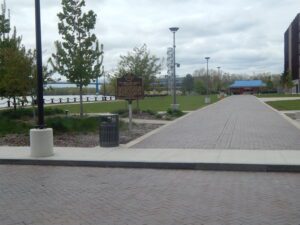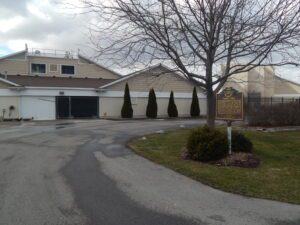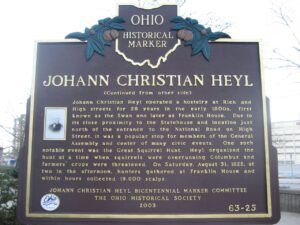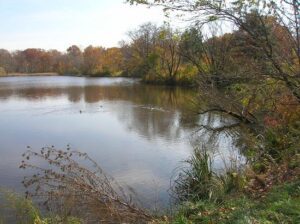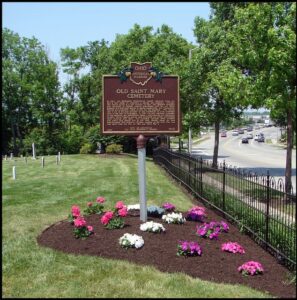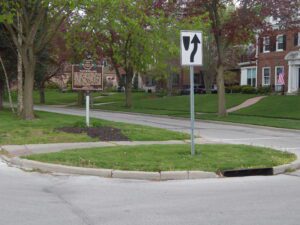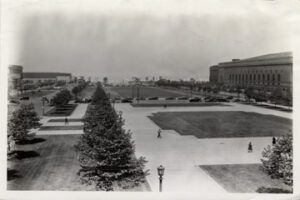, OH
On the night of January 3, 1894, Toledo’s largest fire broke out in the massive King-Quale grain elevators. A westward wind from Maumee River drove flames toward the center of Toledo’s business district. The blaze destroyed several buildings including the Chamber of Commerce and the West and Truaz building. Despite the best efforts of city firefighters using horse-drawn steam pumpers, the fire continued until a serendipitous shift in the winds allowed the firefighters to contain the conflagration.
, OH
In 1931, the France Stone Company ceased operations. Robert Burge leased 19 acres of the site for recreational swimming and opened Centennial Quarry in 1934. Five years later, Burge and associates opened Centennial Terrace, whose centerpiece was “Dancing Under the Stars,” an outdoor, 10,000 square-foot Terrazzo dance floor. Centennial Terrace was a regular stop for many big bands of the 1940s and ’50s. In 1969, the complex was donated to Lucas County and local band leaders kept the people dancing from 1971 to 1993. In 1994, the City of Sylvania leased the facility and renovated and reopened the quarry. The Sylvania Area Joint Recreation District purchased the complex in 2007 and made further improvements to insure that Centennial Terrace and Quarry remains a popular recreation destination.
, OH
Johann Christian Heyl (1788-1877), the first German and first Lutheran to settle in Columbus, was one of the original 15 settlers of the city. A baker by trade, Heyl came to bake for the soldiers quartered in Franklinton during the War of 1812. He founded the city’s first Lutheran Church and helped financially underwrite the German Theological Seminary, which later became Capital University. An early civic leader, Heyl served on City Council for 14 years, was County Treasurer for 8 years, an associate judge in the Court of Common Pleas for 14 years, was appointed to the first public school board, and was the first Chief of the Fire Department. His Sunbury Road home was a stop on the Underground Railroad. (continued on other side)
, OH
Dedicated in 1939 in a ceremony that turned the gardens over to the city, the Cleveland Cultural Gardens are a unique memorial to world peace and the celebration of cultural diversity. The Gardens date to 1916 when the Shakespeare garden was built, and are a celebration of cultural identity in the form of natural landscaping, formal architectural elements, and commemorative sculpture. Consisting of 23 individual gardens, the Gardens reflect the diversity of cultures that shaped Cleveland and the nation. The Gardens pay tribute to the many philosophers, scientists, composers, and other great thinkers who have made significant and lasting contributions to civilization. More importantly, the Gardens are symbolic of the fact that through preservation of many different traditions, beliefs, and practices, we may be better able to accept and respect one another – that we may achieve a true and lasting peace through mutual understanding.
, OH
In 1822, Ralph Russell, a Connecticut pioneer who had settled in Warrensville Township ten years earlier, founded the North Union Shaker Community. The Shakers created Horseshoe Lake in 1852 when they built a dam across Doan Brook and harnessed its waterpower to operate a woolen mill near Lee Road and South Park Boulevard. The community disbanded in 1889; its 1,366 acres were eventually sold to a real estate syndicate from Buffalo, New York, the Shaker Heights Land Company. In 1896, this group deeded the Shaker Lakes Parklands to the City of Cleveland to preserve the green space in perpetuity. Ten years later, the Van Sweringen Company began to develop Shaker Heights Village as a Garden City suburb where William J. Van Aken served as mayor from 1915 until 1950. In the 1960s local residents successfully fought the proposed Clark Freeway, saving Horseshoe Lake and the Parklands from destruction.
, OH
In 1801, the Springdale Presbyterian Church acquired these two and a half acres to construct a church and cemetery. Although the church moved to a new location in 1833, the cemetery remained and continued to receive regular internments until the mid 1950s. Because of a continued decline in church membership, the Presbyterian Church was eventually unable to care for the cemetery. The church felt it was in the best interest of the community to turn ownership over to the City of Springdale. In 1987, the city received ownership of the cemetery and immediately began a maintenance and restoration project. Many forgotten graves were uncovered and broken gravestones were restored and reset. The cemetery contains seven hundred and thirty nine graves and is the final resting place for nine Revolutionary War veterans, thirteen veterans of the Civil War, and one each from the War of 1812 and World War I.
, OH
In 1915, real estate developers William B. Welles and Badger C. Bowen formed the Ottawa Park Realty Company and in 1917 platted 323 residential lots near Toledo, Ohio. Named “Westmoreland” for the similarities with the rolling landscapes of Westmoreland County, Virginia, the neighborhood was placed on the National Register of Historic Places in 1986. Westmoreland features 215 original homes, most representing architectural Revival styles of the early 20th century including those of the Colonial, Jacobethan/Tudor, Italianate, French, and Spanish Revivals. This marker commemorates the centennial of the founding of Westmoreland. (Continued on other side)
, OH
In August 1903, architects Daniel H. Burnham, John M. Carrere, and Arnold W. Brunner presented Mayor Tom L. Johnson and the City of Cleveland a plan that epitomized the City Beautiful Movement in America. The Group Plan envisioned a grand landscaped mall surrounded by public buildings in the Beaux-Arts style. The plan would create a monumental civic center, influence the design of buildings throughout the city, and lay the foundation for a city planning commission. The first of its kind in the nation, the Group Plan, as built, was the most completely realized of Burnham’s city planning efforts. In its green space and architecture, the Mall remains an enduring and vital element of Cleveland’s civic culture. (continued on other side)


